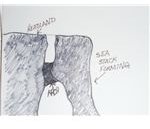

This leads us to recognize two different types of coasts on the basis of whether they have experienced a relative sea level fall or relative sea level rise. You will learn a lot more about changes in sea level later in this course but, for now, keep in mind that many lines of geologic evidence exist for a long history of relative sea level changes. When we can observe evidence of a change in sea level elevation, whether it be an increase or a decrease of elevation, we call it a relative sea level change because we may not necessarily know what mechanism actually contributed to the observed change. Because the land surface is being uplifted, there is an apparent fall of sea level elevation, even though the total volume of water in the ocean basins has not changed. Consider, for example, keeping global sea level steady along an active plate tectonic margin where the coast is being uplifted. There are, however, other ways to change the apparent elevation of sea level along a coast. In this case, sea level was below the current sea level elevation because of actual volumetric changes to the amount of water stored in the ocean basin.

For example, about 18,000 years ago, when large ice sheets were present on the planet during a period of cooler climate, sea level was approximately 120 meters lower than it is today because a large volume of ocean water was frozen in ice sheets at that time. It varies locally on a daily basis because of the phenomenon of tides but has also changed across much longer time periods. The elevation of sea level has not always been constant.


 0 kommentar(er)
0 kommentar(er)
